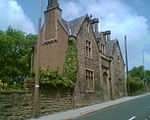Netherthong
AC with 0 elementsGeography of HolmfirthHolme ValleyTowns and villages of the Peak DistrictUse British English from October 2019 ... and 1 more
Villages in West Yorkshire

Netherthong is a village in the civil parish of Holme Valley, and the metropolitan borough of Kirklees in West Yorkshire, England. The village is near the town of Holmfirth, and on the B6107 road to Meltham from the main A6024 Woodhead Road through the Holme Valley from Honley to Holmfirth. It has an estimated population of 1,738 (2018).
Excerpt from the Wikipedia article Netherthong (License: CC BY-SA 3.0, Authors, Images).Netherthong
Denham Drive, Kirklees Holme Valley
Geographical coordinates (GPS) Address Nearby Places Show on map
Geographical coordinates (GPS)
| Latitude | Longitude |
|---|---|
| N 53.583 ° | E -1.793 ° |
Address
Denham Drive
Denham Drive
HD9 3HA Kirklees, Holme Valley
England, United Kingdom
Open on Google Maps











